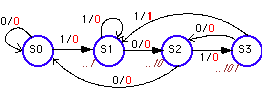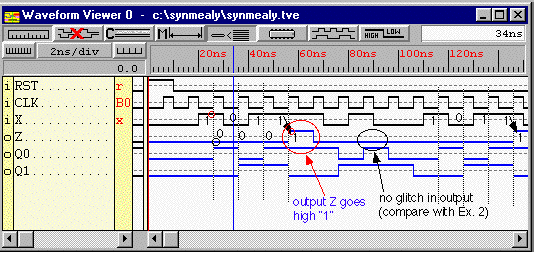
The following state diagram (Fig. 1) describes the same finite state machine as in the previous example: a sequence detector with one input X and one output Z. The FSM asserts its output Z when it recognizes the following input bit sequence: "1011". The machine will keep checking for the proper bit sequence and does not reset to the initial state after it has recognized the string. In contrast to the previous example, the machine will be implemented as a synchronous Mealy Machine. This will ensure that the output changes at the clock transition and will prevent glitches which were possible with the Mealy Machine implementation (see previous example).

Figure 1: State diagram, describing the sequence detector ("1011") implemented as a Mealy machine. The number in italics underneath the states indicate which part of the sequence the state remembers.
This state diagram can be defined in ABEL code given in Listing 1. The output is described with the "With" keyword to indicate that the output will change when the input goes to one. The difference with the regular Mealy machine, is that the output Z is now also clocked (see e.g. the statement, [Q1,Q0,Z].CLK =CLOCK). Also, in the State Diagram section, the "WITH Z:=0" makes use of the registered assignment ":=" operator.
Listing 1: ABEL source code for the Mealy Machine implementation of the sequence detector described in Fig. 1
Declarations
"Input and
output signals
X, CLOCK, RST
PIN;
Z PIN istype
'reg';
Q1, Q0 PIN
istype 'reg';
"State register
definitions
" and assignments
of state values
SREG = [Q1,Q0];
S0 = [0,0];
S1 = [0,1];
S2 = [1,0];
S3 = [1,1];
Equations
"Define the
clock signal for the state machine
[Q1,Q0,Z].AR
= RST;
[Q1,Q0,Z].CLK
=CLOCK;
"Define state diagram
STATE_DIAGRAM SREG
STATE S0: IF
X THEN S1 ELSE S0;
STATE S1:
IF X THEN S1 ELSE S2;
STATE S2:
IF X THEN S3 ELSE S0;
STATE S3:
IF X THEN S1 WITH Z:=1; ELSE S2;
end Syncdet1

Figure 2: Simulation of the sequence detector for "1011" described
with the state diagram of Fig. 1, implemented
as a synchronous Mealy machine. (Screen clip from Xilinx XACTstep(TM)
Foundation software)
Notice that the output Z is valid after the positive clock edge (in response to the input value just before the positive clock edge). The output asserts at the positive clock edge when the input has gone through the sequence "1011". Notice also that the glitch which was present in the non-synchronous Mealy machine is gone.
This timing in a synchronous Mealy machine is thus less critical than in a non-synchronous machine. The price one pays for this, is additional hardware. Making the output synchronous requires additional flip-flops as is illustrated by the blue box (Output Registers) in the generic block diagram of a synchronous Mealy machine in Figure 3.
